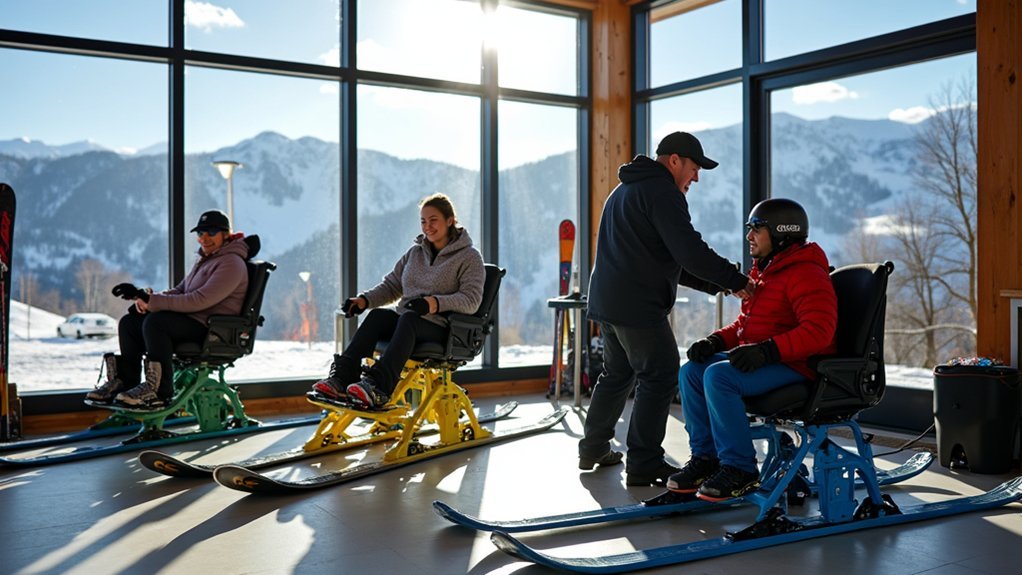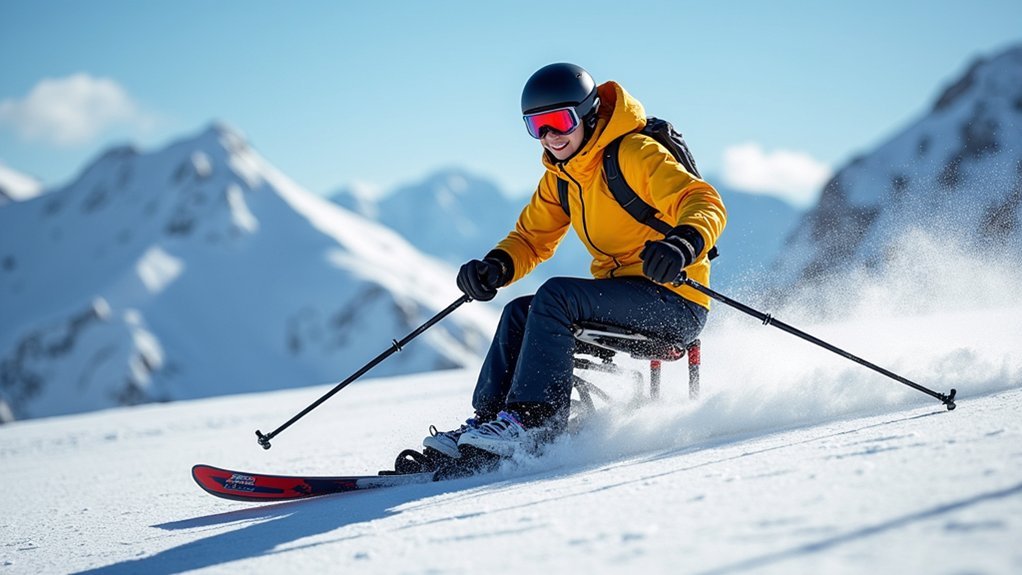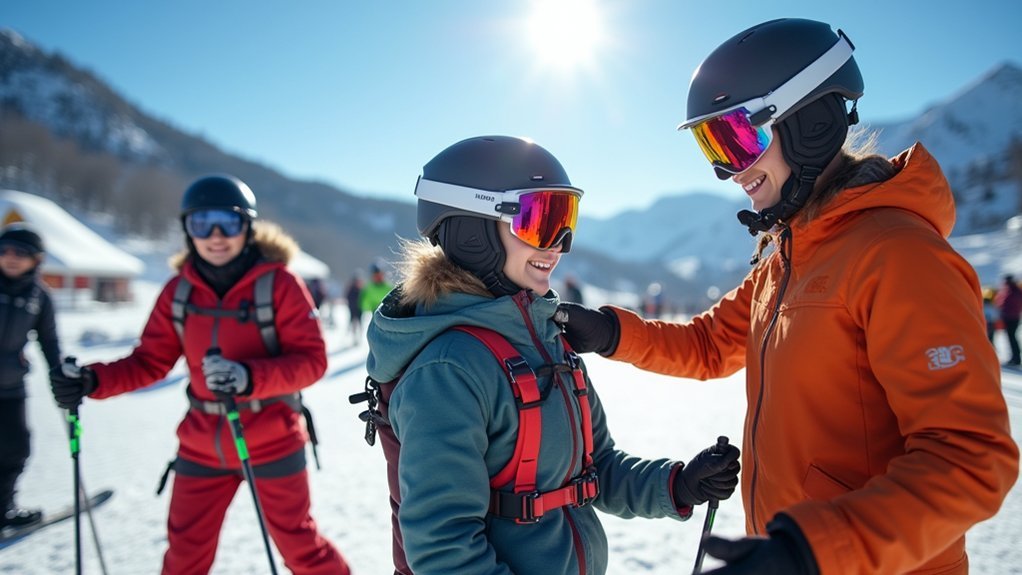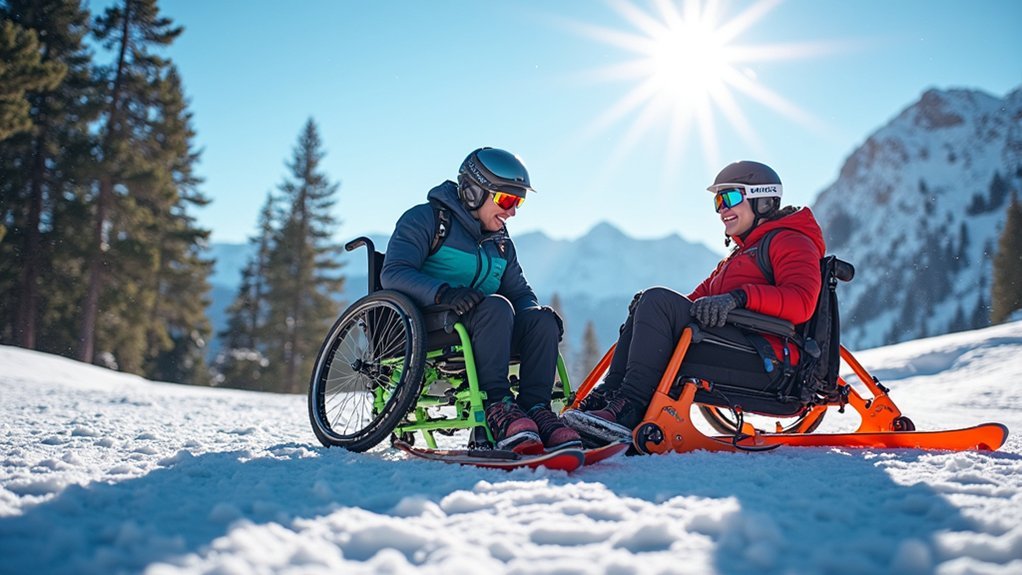Adaptive ski centers offer specialized equipment for disabilities including monoskis, biskis, and outriggers tailored to your mobility needs. You’ll find sit-down options like kart skis for limited arm functionality, stand-up modifications with balance supports, and guidance systems for visual impairments. Many facilities provide wheelchair-compatible attachments and essential safety accessories. Rental programs prioritize personalized fitting to guarantee your safety and enjoyment on the slopes. The right adaptive equipment can transform your winter sports experience.
Sit-Down Adaptive Skiing Equipment Options

Four primary sit-down adaptive skiing options give disabled athletes the freedom to hit the slopes with confidence.
The monoski features a single ski with handheld outriggers, perfect if you’ve got good balance and upper body strength.
For those needing more stability, the biski offers two skis underneath your seat and can be used independently or with assistance.
If you have limited arm functionality, consider the kart ski with its wider base and convenient hand control bars that let you manage your speed effectively.
The tetra ski provides an advanced solution for athletes with minimal strength, featuring joystick or sip and puff controls, though you’ll typically need tethering for safety.
Stand-Up Adaptive Skiing Modifications
Stand-up adaptive skiing offers you customizable outriggers that improve your balance and control while traversing slopes with different mobility levels.
You’ll find these specialized poles with attached mini-skis in various designs, from fixed-rigidity models for beginners to adjustable options that accommodate your growing skills.
For enhanced stability, you can complement your outriggers with additional balance equipment, including specialized foot platforms, ski-bras that connect ski tips, and tethering systems that provide security without limiting your independence.
Outrigger Ski Options
Balance and stability form the foundation of successful adaptive skiing, which is why outriggers have become essential equipment for many disabled athletes. These lightweight devices provide vital support that enhances your control on the slopes, especially during turns and stops.
When exploring outrigger ski options, you’ll find they’re typically secured with Velcro attachments, making customization simple and effective. They’re designed to work with various skiing positions, accommodating your specific needs if you have decreased coordination or balance challenges.
You’ll appreciate how outriggers facilitate navigation on ski lifts, ensuring safe ascents and descents. Beyond technical support, they greatly boost your confidence and independence on the mountain.
With proper outrigger assistance, you’ll experience improved performance while enjoying greater autonomy during your adaptive skiing adventures.
Balance Enhancement Equipment
While mastering the slopes with physical limitations presents unique challenges, adaptive skiing modifications have revolutionized accessibility on the mountain. You’ll find specialized equipment designed to provide essential stability and control during your adaptive skiing journey.
| Equipment | Best For | Benefits |
|---|---|---|
| Outriggers | Three-track/Four-track skiing | Lightweight balance aids that facilitate turns and stops |
| Three-track Setup | Limb differences/Amputations | One ski with two outriggers for enhanced stability |
| Snow Slider | Balance/Strength challenges | Walker-mounted skis providing progressive support |
Standing-length outriggers offer snowboarders that vital extra point of contact with the snow. Four-track skiing creates four points of ground contact, making it ideal if you have conditions like cerebral palsy. These innovations guarantee you can enjoy the thrill of the mountain regardless of physical abilities.
Outrigger and Balance Support Systems

When choosing outriggers for adaptive skiing, you’ll need to assess the latest technologies featuring Velcro attachments that enhance stability during turns and stops.
Your selection of balance equipment should complement other adaptive gear like mono-skis or tri-skis to maximize control and confidence on the slopes.
Proper fit considerations include adjustable height settings and lightweight materials that won’t hinder your maneuverability while traversing ski lifts or practicing new techniques.
Adaptive Outrigger Technologies
The versatile outrigger system stands as a cornerstone technology in adaptive skiing, enabling disabled athletes to traverse slopes with confidence and independence. Crafted from lightweight materials, these adaptive equipment pieces feature Velcro attachments that enhance stability while you’re skiing in either seated or standing positions.
You’ll find outriggers particularly helpful if you have decreased coordination, as they provide a wider base of support and an additional point of contact with the snow. They’re engineered to assist you in executing turns, stopping safely, and maneuvering ski lifts.
What makes outriggers especially valuable is their customizability. They can be adjusted to meet your specific needs and abilities, allowing you to progress at your own pace while reducing fall risks and empowering you to ski independently.
Balance Equipment Selection
Beyond the basic outrigger technology lies an extensive world of balance support systems tailored to your specific skiing needs.
When selecting balance equipment, you’ll find outriggers are used with various adaptive skiing setups including mono-skis and tri-skis to support decreased coordination.
For ideal performance on the slopes, consider these key selection factors:
- Lightweight materials that provide stability without adding unnecessary burden
- Velcro attachments for quick adjustments while maneuvering turns, stops, and ski lifts
- Proper fitting assessment to guarantee safety and maximize performance potential
- Compatibility with other equipment to create a thorough adaptive skiing system
The right balance equipment greatly increases your confidence and independence, transforming your skiing experience from challenging to enjoyable regardless of physical limitations.
Support Fit Considerations
Proper fit of your outrigger and balance support systems directly impacts your skiing control, comfort, and safety on the slopes.
When renting adaptive skiing equipment, verify outriggers feature lightweight materials that won’t fatigue your arms while providing essential stability during turns and stops.
The Velcro attachments should secure firmly to your arms whether you’re in a seated or standing position. These attachments shouldn’t restrict movement but must remain snug enough to transfer your body’s movements to the outrigger effectively.
Remember that well-fitted outriggers are vital for maneuvering ski lifts safely.
If you experience decreased balance or coordination, properly adjusted support systems will make your skiing experience more enjoyable by providing those additional points of contact with the snow that enhance your stability throughout the day.
Specialized Equipment for Visual Impairments

Modern adaptive skiing equipment opens up exciting possibilities for visually impaired athletes on the slopes. When renting ski gear, you’ll find specialized tools designed to enhance safety and independence while traversing downhill terrain.
The essential adaptive ski equipment for visually impaired skiers includes:
- Radio headset systems that provide real-time directional guidance from instructors
- Rounded outriggers paired with tethering systems for improved stability and control
- Reflective vests that increase visibility to other skiers in crowded areas
- Specialized communication devices that maintain constant contact between you and your guide
These technologies work together to create a secure skiing experience, allowing you to enjoy the thrill of winter sports despite visual limitations.
Rental facilities increasingly offer these specialized tools as part of their commitment to inclusive winter recreation.
Adaptive Snow Transportation Beyond Skiing
While skiing dominates winter sports conversations, adaptive snow transportation extends far beyond traditional downhill activities.
You’ll find innovative track systems that attach directly to wheelchairs, enabling you to navigate snow-covered paths with unprecedented ease. These customizable systems fit various wheelchair models, ensuring you’re not limited by your specific equipment.
Battery-powered track systems offer efficient mobility across winter terrain, eliminating barriers that traditionally restrict wheelchair users.
These revolutionary power systems transform snowy landscapes from obstacles into accessible pathways for wheelchair users.
For improved stability on icy surfaces, wheel blades attached to your chair’s front wheels provide better traction and control.
These adaptive snow transportation solutions aren’t just practical—they’re transformative, allowing you to participate in winter outdoor activities independently.
The technology behind these systems continues to evolve, creating more inclusive opportunities for you to enjoy snowy environments alongside friends and family.
Rental Programs and Accessibility Services
Seamless access to adaptive equipment forms the foundation of inclusive winter sports programs nationwide.
Before you hit the slopes, you’ll need a personalized fitting and assessment to guarantee your skiing experience is both safe and enjoyable. Staff will evaluate your needs and approve specific equipment based on your abilities.
Rental programs offer:
- Full-day access to specialized gear including Nordic skis, mono skis, and ski bikes
- Priority rental systems that support independent recreation with family and friends
- Equipment tailored to your individual skill level and physical requirements
- Assistance with group adventure planning for families and organizations
These extensive services guarantee you can fully participate in outdoor winter activities with the right adaptive equipment matched to your specific needs.
Essential Accessories for Comfort and Safety
Beyond the primary adaptive equipment, specialized accessories play an essential role in maximizing your safety and comfort on the slopes.
When skiing, you’ll benefit from skull caps that provide extra padding under helmets, enhancing your head protection while maneuvering challenging terrain.
Leg covers are essential for seated skiers, shielding you from cold elements and helping maintain ideal body temperature.
For knee stability, consider knee support orthoses with spring recoil systems that maintain leg extension, reduce pressure, and improve control during skiing maneuvers.
Don’t overlook outriggers, available for both seated and standing positions.
These versatile tools greatly enhance your balance and control, allowing you to execute smoother turns and stops.
These accessories aren’t merely add-ons but critical components that guarantee both your safety and enjoyment.
Frequently Asked Questions
What Is Disabled Skiing Called?
Disabled skiing is commonly called adaptive skiing. You’ll find specialized forms like sit skiing, which includes monoskiing and biskiing. These approaches use modified equipment to let you enjoy the slopes regardless of your disability.
What Ski Equipment Can You Rent?
You can rent adaptive equipment like mono skis, biskis, kart skis, and tetra skis for disabled skiing. Nordic skis with poles are available for $15/day, while specialized ski bikes are also rentable during operating hours.
What Is Skiing for Wheelchair Users?
You can enjoy skiing using adaptive equipment like monoskis, biskis, or kart skis designed for wheelchair users. With outriggers for balance and specialized lessons, you’ll experience the thrill of gliding down slopes independently.
What Is an Adaptive Ski Program?
An adaptive ski program allows you to enjoy skiing despite disabilities. You’ll receive specialized equipment like monoskis or biskis, plus personalized instruction from trained coaches who’ll adapt teaching methods to your specific needs and abilities.
In Summary
You’ve got many options for adaptive ski equipment rentals that’ll support your specific needs. Whether you’re looking for sit-skis, outriggers, or visually-impaired guidance systems, specialized rental programs exist nationwide. Don’t hesitate to call resorts in advance to guarantee they have your required equipment. With the right gear and support services, you’ll experience the thrill of the slopes regardless of your disability.





Leave a Reply